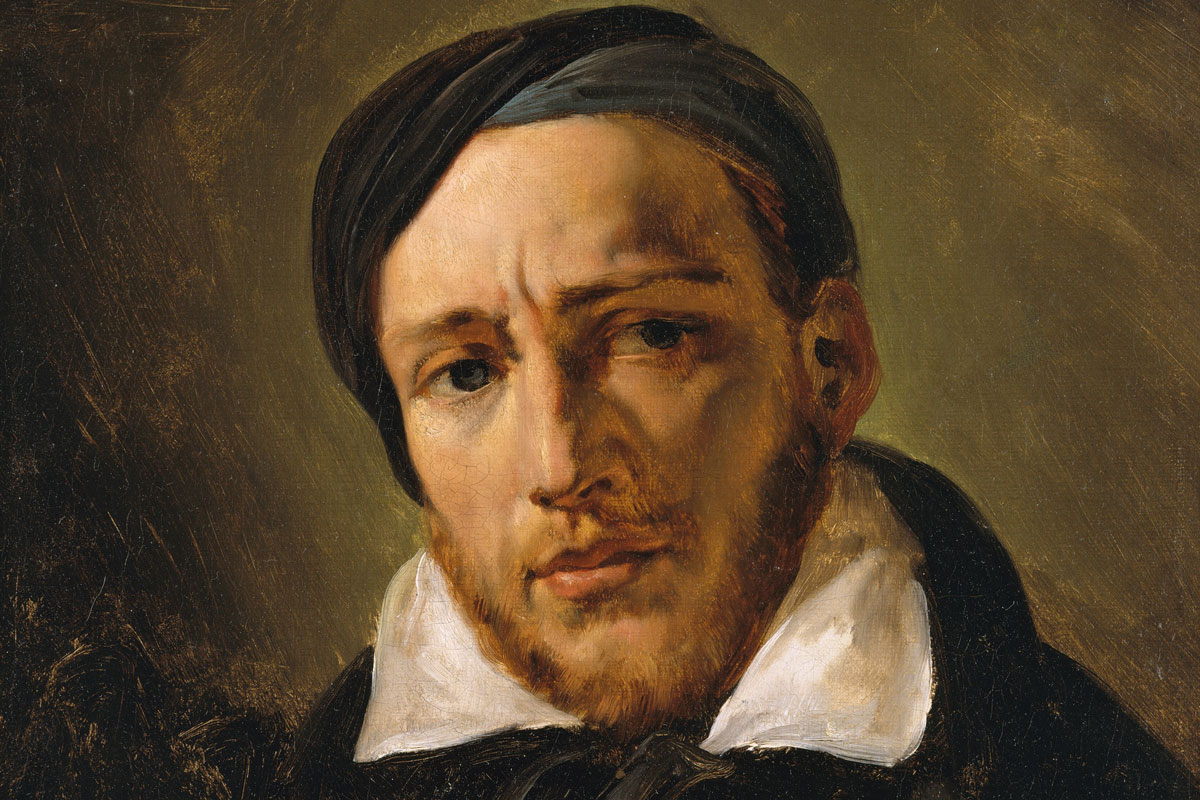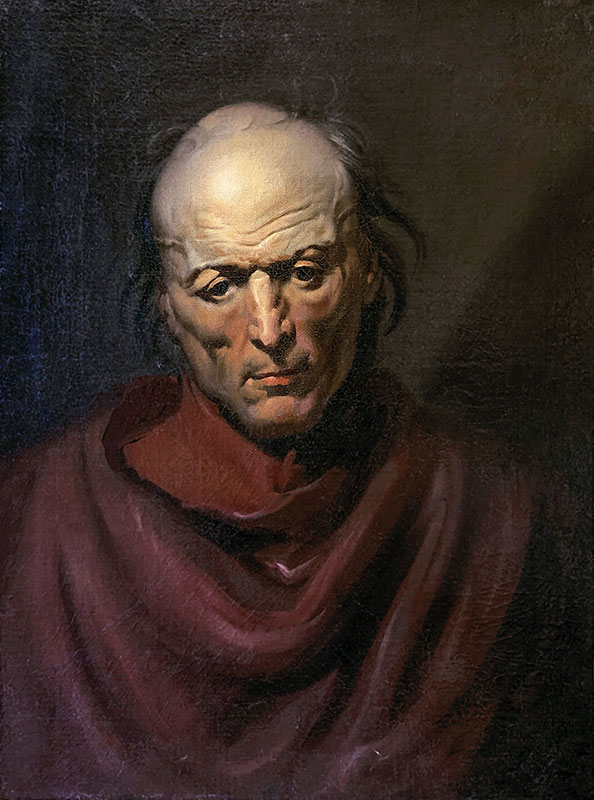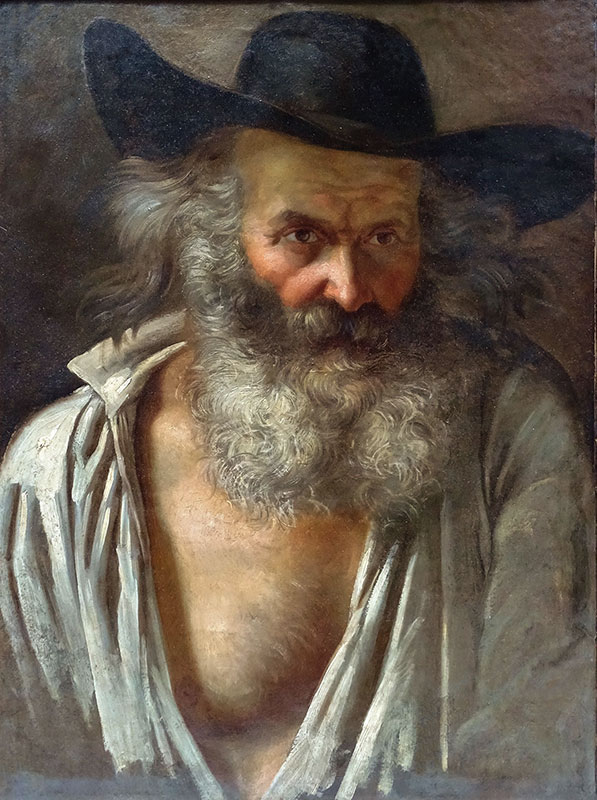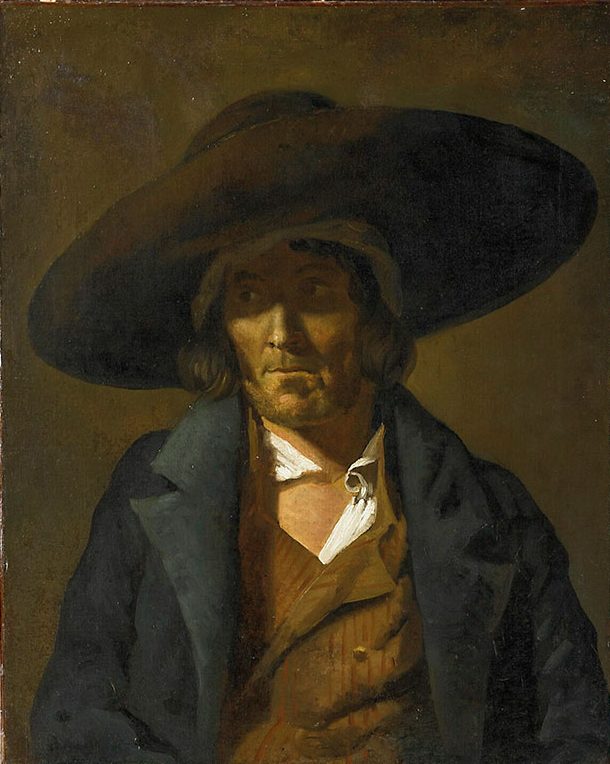In search of Théodore Géricault’s lost monomanias
An artistic and scientific mystery spanning two centuries

Viardot’s letter
Rarely do art and science conspire in this way to offer us mysteries to solve. Rarely do such conundrums last so long. Rarely are we able to look into the past and find the hidden answer.
This mystery surfaced in December 1863, in the form of a letter recounting what had happened forty years earlier in the depths of the Parisian psychiatric asylums, in the cold winter of 1822–1823. Alienism was living a golden age, following the publication of Philippe Pinel’s treatise in 1801, entitled Traité médico-philosophique sur l’aliénation mentale, ou la manie (Pinel, 1801). Jean-Étienne Dominique Esquirol and his young disciple Étienne-Jean Georget analysed and described the cases of lunatics who populated the various hospices of the city, where the marginalised and delinquents were mixed with the mentally ill, albeit separated by gender, of course. The Hôpital de la Salpêtrière (now Pitié-Salpêtrière) was for poor women, while the Hôpital de Bicêtre was for sick men from the less well-off classes. The wealthier could go to private asylums, such as Esquirol’s one, at 9 rue Buffon, just opposite the Jardin des Plantes, where the majestic Gallery of Paleontology and Comparative Anatomy is located in the Parisian capital.
But, as I was saying, the enigma hid in that letter. The letter was addressed to Charles Blanc, editor of the prestigious art journal Gazette des beaux-arts, by Louis Viardot, a renowned French humanist and Hispanist. Viardot entitled the letter «Five studies of the alienated», and in it he told the following story: an enigmatic Doctor Lachèze (whose first name we still do not know almost two centuries later) contacted the humanist to inform him that he had found five unpublished portraits by the master of French Romanticism, Théodore Géricault, the author of The raft of the Medusa. Viardot said that Dr. Lachèze had kept these five portraits for thirty-nine years and that these works had accompanied the doctor on every journey he had made over the decades: Egypt, Palestine, Arabia, Persia… The meeting between the two scholars took place in an attic in Baden-Baden, and Lachèze showed Viardot some portraits stored in an old moth-eaten chest, the canvases rolled up one on top of the other, with no frames or stretcher bars.
The Lachèze series
These five portraits, corresponding to two women and three men (Figure 1), represented, according to Lachèze, five patients in Parisian asylums suffering from a very specific type of illness: monomania. This category of illness had been described by Dominique Esquirol as a partial delirium characterised by a specific obsession with an object. The patient only manifested the illness in response to the specific cause of the delirium; the rest of the time the monomaniac behaved like a healthy, rational and reasonable person. Esquirol defined five nosological categories of illness; melancholia or lipemania, monomania, mania, dementia, and idiocy, anticipating by almost two hundred years the concept of the progressive course of dementia that we have today. Furthermore, in Esquirol’s words, monomania was «an intermediate species between lipemania and mania». He explained that this type of illness «participates in lipemania though the fixation and concentration of ideas, and in mania through the exaltation of ideas and though physical and moral activity».
The definition of this category of mental alienation marked Esquirol’s medical career in the early years of the century, but also that of the whole school of French alienists who had been educated under the teachings of Pinel and Esquirol himself. Monomania thus permeated all of Esquirol’s writings, and those of his disciples, with Étienne-Jean Georget at the head, who published his treatise De la folie in 1820 (Georget, 1820). Georget developed the ideas of his master, with whom he worked for most of his professional life, and redefined mental alienation, classifying it, once again, into five categories of illness: idiocy, mania, monomania, stupidity, and dementia. Today, monomania has already lost its scientific rigour; it began its decline in 1854, in fact, when Jean-Pierre Falret, another alienist from Esquirol’s circle, published his article «De la non-existence de la monomanie» (Lepoutre & Dening, 2012).

Figure 1. The five known monomanias by Théodore Géricault. From left to right: Monomania of envy, 58.5 × 72.1 cm; Monomania of thieving, 50.1 × 61.2 cm; Monomania of military rank, 65 × 81 cm; Monomania of gambling, 77 × 65 cm, y Monomania of child snatching, 64,8 × 54 cm. All of them are oil paintings on canvas. The series was painted in 1822–1823, although some catalogues date them between 1821 and 1824. In any case, these were the last works painted by Géricault before he fell ill at the beginning of 1823. / Museum voor Schone Kunsten Gent
But coming back to the scientific-artistic mystery, and according to Viardot’s letter, Georget was precisely the alienist who commissioned Théodore Géricault to immortalise a series of alienated people suffering from monomania due to various causes. And Géricault painted the portrait of the five insane confined in the Parisian asylums with a realism and genius befitting the Romantic master. These were the last oil paintings he worked on in his life, which ended at the age of thirty-two due to complications suffered after falling off a horse. As fate would have it, he died at the same age as Dr. Georget, the latter from tuberculosis.
The monomaniacs portrayed by Géricault at the request of the young alienist suffered from monomania due to five specific causes: gambling, kleptomania, child snatching, megalomania (or monomania of military rank) and envy (the woman who suffered from it was identified by Lachèze as «the Hyena» at the Salpêtrière hospital).
These five portraits, known today in the art world as Les monomanes, have become a paradigmatic series for both science and art history, and can be seen in five major art galleries around the world. The five works are three-quarter portraits, with their faces illuminated against a dark background, all dressed in winter clothes, and with a series of physiognomic expressions which, according to the alienists of the time, allowed the trained specialist to identify the causes of insanity. It seems that one of the reasons for commissioning such a series was to illustrate the students of the Paris Medical School during their classes, but also to accompany the treatises of the alienists who were beginning to describe the first nosological categories of mental illness.
And this could be the end of the story of Géricault’s monomania series. But Viardot’s letter contained a hidden Easter egg. Viardot said that Géricault had painted not five portraits of the insane, but ten. Georget commissioned the series of ten portraits and kept them from the time they were given to him by Géricault (probably at the beginning of 1823) until the end of his life in May 1828. Upon his death, Georget’s most prized possessions were divided among his relatives, while others considered of lesser value were auctioned off. Two young doctors, who did not have enough money to buy Georget’s books, decided to buy the ten portraits at an auction, dividing them into two groups of five. One of them was Dr. Lachèze, who showed the portraits to Louis Viardot in the Baden-Baden attic almost forty years later. The other five were taken by another doctor to his home town in Brittany. That second doctor’s surname was Maréchal, and we still do not know his name either, so there is no chance of tracing what he did with his part of the series. So the five monomanes taken by this second doctor have remained hidden for two centuries, ever since Géricault painted them in the distant Parisian winter of 1822–1823. No one had seen them since then; some experts even doubted that they had ever existed, and art historians who thought they had existed claimed that they were forever lost.
Monomania of religion: the melancholic man
Everything changed in January 2021. The first of them emerged (Burgos, 2021). It was a portrait that had been shown in a temporary exhibition at the Ravenna Museum in 2013, called «Borderline. Artists between normality and insanity. From Bosch to Dalí, from Art Brut to Basquiat». The portrait (Figure 2) was a previously unknown painting by Géricault, one no one had seen before and which was not even part of the artist’s corpus, although it was attributed to the French painter in the exhibition catalogue. But it went completely unnoticed in that small exhibition more than a decade ago. It took eight years for the portrait of the melancholic man to be associated with the series of Les monomanes commissioned by Georget. To propose that a portrait belongs to the lost series, three requirements must be met: it must be attributed to the French painter (as was the case in the 2013 Ravenna exhibition), the pictorial style (dimensions, colour palette, style…) must coincide with the series (and it did, according to all the analyses), and the cause of the illness must be described in the treatises of the alienists. The latter was also true. Georget, in his treatise De la folie explained: «Esquirol divided insanity into two types: monomania with excitement, and monomania with dejection, sadness, which he named lipemania, and which corresponds to the melancholy of all authors». So there was a melancholic type of monomania, and it had not been represented in the known part of the series belonging to Dr. Lachèze. If we look closely at the melancholic man, we can see that he is undoubtedly a religious: he is wearing a chasuble and we can see the tonsure on his head. And this also coincides with the writings of the alienists, since both Georget and Esquirol considered religion one of the possible causes triggering mental alienation, and this association appeared again and again in their texts as a cause of monomania. Thus, the portrait fulfilled all three requirements, so the cause of the associated monomania was determined to be religion, which in this case was accompanied by dejection and sadness.

Figure 2. Théodore Géricault. Portrait of a man (Homo melancholicus). Monomania of religion, 1822–1823. Oil on canvas, 47 × 62 cm. / Private collection (Italy)
Monomania resulting from drunkenness
The second lost monomania (Figure 3) appeared just a year later, in a small art gallery in the city of Versailles: the Meier gallery (Burgos, 2022). Again, it fulfilled the three characteristics necessary to be assigned to the series. The cause of this patient’s monomania was drunkenness (deduced from pictorial comparisons of the time and from the characteristics of the painting). It was one of the most common reasons for mental alienation in the Parisian asylums of the early 19th century, according to the texts of the alienists. Again, Georget and Esquirol agreed that excessive drinking could trigger monomania. According to Georget, in the men’s asylum in Bicêtre, as many as 106 patients out of a total of 1,079 had alcohol abuse as the cause of their mental illness. Esquirol asked: «Who can deny that there is a mental illness whose main characteristic is an irresistible impulse towards fermented beverages? On close observation, all the characteristic features of partial madness, of monomania, can be found there». And he did not stop there: he even devoted twelve pages to «monomania resulting from drunkenness» in his medical treatise Des maladies mentales (Esquirol, 1838).
But the definitive proof that the new painting was one of Les monomanes was on the back of the canvas, where a yellowish label, partially torn and tarnished by the passage of time, could be seen. The text proved to be definitive. It read: «This portrait of an alienated man painted by Géricault was given to me by the widow… of D…. Maréchal in 1866. Paris, 9 November… Louis Lemaire».

Figure 3. Théodore Géricault. Monomania of drunkenness (n.d.). Oil on paper, 51 × 70.5 cm. / Meier Gallery, Versailles (France)
Subsequently, a series of spectroscopic analyses were carried out which confirmed that the dating of the paper and the resin of the label corresponded to the second half of the 19th century. The spectra obtained from this paper showed molecular structures corresponding to cellulose and lignin. Processes to dissolve lignin became more efficient in the late 19th century, so the label was from an earlier time. In addition, the cellulose in the paper had oxidised groups in its chains, so it was an aged paper. Finally, infrared spectroscopy revealed the presence of a synthetic resin used from the 1850s onwards, so the date of 1866 written on the label appeared to be real.
Monomania of political strife: the man from Vendée
The third monomania (Figure 4) was hidden in plain sight, and we had to wait until 2023 to discover its existence. The painting was hanged in room 941 of the Louvre Museum, very close to another of the known monomanias: the gambler (Burgos, 2023). This time it was the portrait of the man called the Vendeen. This painting has been attributed to Géricault ever since he painted it, and some specialists date it to the period when Les monomanes were painted. The portrait depicts a man from the Vendée region in France, and was acquired by the Louvre Museum in 1938. Until now it was thought to have been painted during a visit by the French artist to that region of France, where he depicted a villager in traditional clothing. But if one delves into the old records and the writings of historians of the time, the conclusion is that there is no record of Géricault ever having visited the Vendée region. This is recognised, for example, by the historian Bruno Chenique, who states that Géricault painted «a Vendeen without going to the Vendée, black people without going to Africa or the West Indies, and Asian people without going to the East” (Laveissière et al., 2002). Moreover, when the painting was bought by the Louvre museum, René-Doumic, the art historian who was commissioned to publish an article in the Bulletin des musées de France on the occasion of the acquisition, already proposed as a first hypothesis that this portrait could belong to the monomanias series (René-Doumic, 1938). But his claim was then forgotten.

The ultimate proof of this research was to find a clinical case compatible with the one portrayed in Esquirol’s 1838 text Des maladies mentales, where he reviewed cases he had treated during his professional life and where three monomanias from Lachèze’s series were also described: the gambler, the Hyena, and the military commander. According to Esquirol, «during his childhood, this man was exposed to causes of terror, living through the events of the Vendée». Esquirol also indicates that the man was in his thirties when he treated him. Therefore, all the dates coincide with the case, especially if we take into account that the Vendée war took place between 1793 and 1796, when the man was a child, and that Géricault painted him in the winter of 1822–1823, when he was about thirty years old.
Epilogue
These three pictorial (and scientific) discoveries solve the enigma of Géricault’s lost monomania. After carrying out this research, and in view of the proposed assignment of these three new portraits to the series, we can confirm that Georget actually commissioned ten monomania portraits from the Romantic painter. In fact, all the monomania found, from both the Lachèze and Maréchal sections of the series, were described in one way or another in the texts by Esquirol and Georget, which confirms the scientific-artistic connection of the commission. Those ancient texts of the early alienists contained the clues needed to unravel the mystery. They just had to be found and reinterpreted. The key to solving the two-centuries-old artistic enigma lay in researching from the point of view of the psychiatry of the time, rather than from the knowledge of an art historian.
Thanks to these discoveries, we understand that group of alienist doctors a little better. In the early 19th century, these doctors from the Salpêtrière school began to introduce moral treatment as a treatment to cure the mentally ill confined in the inhuman hospices of post-Napoleonic Paris. That group of doctors changed the history of medicine with their alienist ideas. But they also changed, perhaps unconsciously, the course of art history.
However, the story is not yet over. There are still two monomaniacs to be found, so the mystery continues.
References
Burgos, J. S. (2021). A new portrait by Géricault. The Lancet Neurology, 20(2), 90–91. https://doi.org/10.1016/S1474-4422(20)30479-8
Burgos, J. S. (2022). Monomania of drunkenness by Géricault. The Lancet Neurology,21(9), 774–775. https://doi.org/10.1016/S1474-4422(22)00304-0
Burgos, J. S. (2023). Monomania of political strife by Géricault. The Lancet Neurology, 22(6), 468–469. https://10.1016/S1474-4422(23)00159-X
Esquirol, J. E. D. (1838). Des maladies mentales, considerées sus les raports médical, hygiénique et médico-légal. Edited by n. 17 Chez J.-B. Baillière. Libraire de l’Académie Royale de Médecine.
Georget, E. J. (1820). De la folie. Considérations sur cette maladie. Edited by rue de l’École de M. n. 11 à 13 Chez Crevot Libraire.
Laveissière, S., Chenique, B., Esnault, A., & Haudiquet, A. (2002). Autour de La vieille italienne de Géricault: Quatre peintres pour un modèle: Cogniet, Géricault, Navez, Schnetz. C. Cahiers du Temps.
Lepoutre, T., & Dening, T. (2012). “De la non-existence de la monomanie”, by Jean-Pierre Falret (1854): Introduction and translation (Part 1). History of Psychiatry, 23(3), 356–370. https://doi.org/10.1177/0957154X12445421
Pinel, P. (1801). Traité médico-philosophique sur l’aliénation mentale, ou la manie. Editat per C. et Ravier. L. rue H.-F. N. 11 Chez Richard.
René-Doumic, S. (1938). Le portrait du vendéen par Géricault au Musée du Louvre. Bulletin des musées de France, 4, 58–59.





